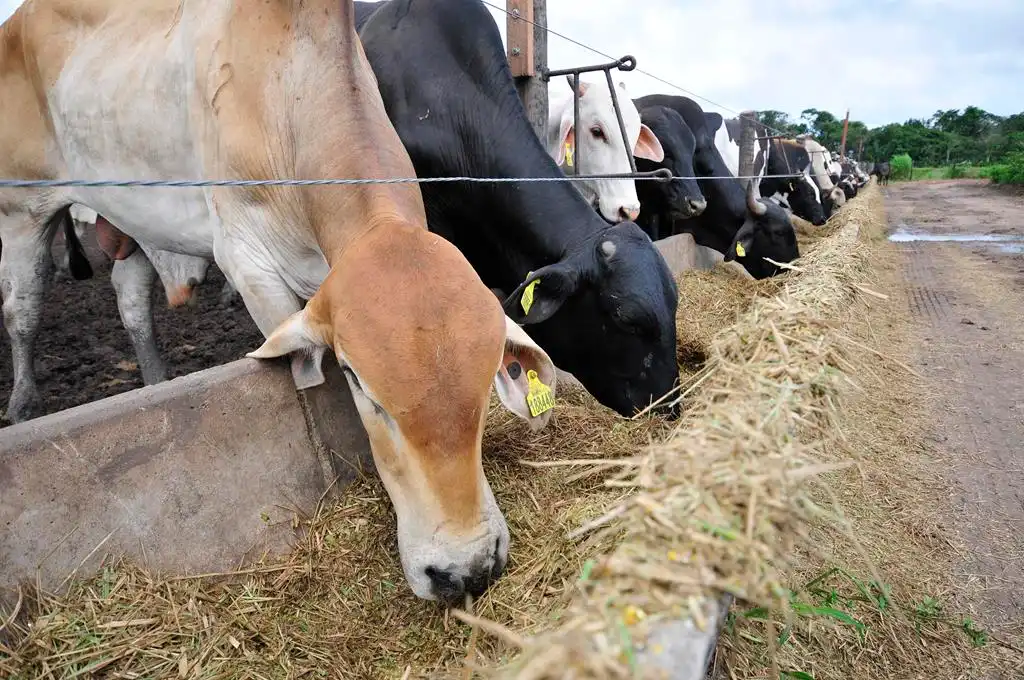The habit of consuming yogurt or fermented milk to care for gut health is so common that few stop to think about the mechanism behind this benefit: live microorganisms that balance the gut flora. Now, this logic — familiar to our daily lives — is migrating to a different scenario: livestock farming. Science is beginning to apply, intentionally and strategically, probiotics and prebiotics to the diet of cattle, not only to improve animal health but also to tackle an urgent climate challenge: the emission of methane (CH₄), one of the most potent greenhouse gases (GHG) in terms of warming potential. Although with a shorter lifespan in the atmosphere, according to the Intergovernmental Panel on Climate Change (IPCC), its global warming potential is up to 25 times greater than carbon dioxide (CO₂) over a 100-year horizon.
Just as practically all human activities generate GHGs, livestock farming is no exception. In the case of ruminants, methane (CH₄) is released primarily during fermentation in the rumen — one of the four compartments of cattle’s stomach — and expelled through eructation (popularly known as a burp). Although these emissions are part of a natural carbon cycle, in which methane released during animal digestion decomposes in the atmosphere, being converted back into carbon dioxide (CO₂) and water (H₂O), which are absorbed by pastureland, as Diana Rodgers and Robb Wolf show in their book, integrating innovative solutions that combine productive efficiency and sustainability is essential for more sustainable livestock farming.
How probiotics and prebiotics work in cattle

Photo: Minerva Foods
In animal nutrition, probiotics are live microorganisms — such as bacteria (Bacillus cereus, Enterococcus faecium, Lactobacillus acidophilus, Ruminobacter amylophilum, Ruminobacter succinogenes, Succinovibrio dextrinosolvens) and yeasts (Saccharomyces cerevisiae) — that already make up the intestinal flora of cattle, but in limited concentrations. Prebiotics, in turn, are non-digestible fibers that serve as food for these beneficial bacteria, stimulating their multiplication and activity.
The combined action of the two modulates ruminal fermentation, improving feed conversion and inhibiting the growth of methanogenic archaea — microorganisms belonging to a different group from bacteria and eukaryotes (to the domain Archaea) — specialized in producing methane as a byproduct of their metabolism. According to the article Probiotics and Prebiotics for Cattle Production: When and How to Use, published in 2020 in the technical journal NutriNews, the benefits go beyond GHG mitigation: better nutrient utilization, increased milk production and quality, greater control of ruminal pH in grain-rich diets, and even an improvement in coat appearance.
Evidence and real-world cases
The results of field research are striking. According to the article “Probiotics can reduce methane from ruminants,” by Leonardo Gottems, published by Portal Agrolink, trials at the University of California, Davis, tested three strains of non-GMO microorganisms from Locus Fermentation Solutions. The combination resulted in a 68% reduction in methane emissions; a single isolated strain achieved 78%. For Keith Heidecorn, director of Locus’s Animal Nutrition division, the data “show a promising path to significantly reduce the climate impact of livestock farming without compromising productivity.”
In Brazil, the startup YLive, a biotechnology company incubated at the Center for Innovation, Entrepreneurship, and Technology (Cietec) of the University of São Paulo (USP), developed segmented probiotics specifically for dairy cattle through a project supported by the Innovative Research in Small Businesses program of the São Paulo Research Foundation (PIPE-FAPESP). In tests conducted on experimental farms, supplementation resulted in a 5% increase in milk production after 45 days, a performance comparable to that of antibiotics such as sodium monensin and virginiamycin, but with the advantage of being natural and leaving no residues in the animal’s milk or meat.
In Hawaii, Parker Ranch tested the addition of the red seaweed limu kohu (Seagraze product, from Symbrosia) to the diet of cattle, achieving an average reduction of 77% in emissions over six months. The success secured over US$2.2 million in federal funding to expand production, as reported in an article by Thomas Heaton in the Honolulu Civil Beat, distributed by the Associated Press.
Meanwhile, in Europe and North America, in a press release, the Dutch multinational DSM — specialized in biotechnology — shared results from trials conducted at the Catholic University of the Sacred Heart (CERZOO) in Italy, with the additive Bovaer (3-Nitrooxypropanol), which achieved reductions of 44% to 50% in enteric methane emissions in dairy cows, while maintaining milk production, its composition, and animal health.
An expanding market
The use of probiotics and prebiotics in animal feed is part of a rapidly growing market. Estimated at US$5.18 billion in 2023, the sector is projected to reach between US8.27 and US9.18 billion by 2030, according to Markets and Markets and Grand View Research, respectively. Within the global animal feed additives market, which encompasses all species and product categories — from growth promoters to preservatives, enzymes, and probiotics — US46.8 billion was transacted in 2024, a value expected to reach US$79.9 billion by 2034, according to News Market. Probiotics already represent 36.1% of this total, making up the largest individual niche.
Within this broader universe, there is a specific segment focused on methane reduction in ruminants, which brings together additives and technologies with proven effects on methanogenesis (a biological process that occurs during ruminant digestion), such as feed additives, probiotics, and red seaweeds. This more restricted niche is projected to grow from US$2.9 billion in 2025 to US$5.2 billion by 2034, driven by the demand for low-carbon solutions in livestock farming, according to Global Market Insights.
By bringing to the trough the logic of what already happens at the consumer’s table, science paves the way for more efficient livestock farming with a smaller carbon footprint, showing that advancements in animal nutrition can play a significant role in the transition to more sustainable food systems through the convergence of science, market, and productive practice.




